May 6, 2015 | Video Reviews
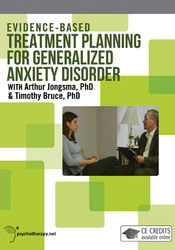
In their comprehensive and user-friendly video, Evidence-Based Treatment Planning for Generalized Anxiety Disorder, Drs. Arthur Jongsma and Timothy Bruce provide a core foundation for understanding as well as treating generalized anxiety disorder—all within 70 minutes. Additionally, the authors adequately demonstrate how research can be translated into practice by using an evidence-based framework to treat symptoms consistent with generalized anxiety disorder. Other benefits include the transcript provided with the video because it enables viewers to follow along with ease, as well as provides the variety of learning methods included in the video, such as the dialogue throughout the interview, PowerPoint slides, and case vignettes that include exchanges between a practitioner and client.
In order to provide their audience with an organized, step-by-step guide for counseling an individual presenting with generalized anxiety disorder, Bruce and Jongsma (2012) incorporate six modules and four clinical vignettes to best illustrate their treatment practices. Specifically, the authors address DSM criteria and related clinical features, provide a historical framework that highlights the movement towards empirically supported treatments, emphasize key elements for treatment planning, target relapse prevention, and utilize a six-step treatment planning process grounded in evidence-based practices. Throughout the video, terms are clearly and explicitly defined.
In addition to highly educational information, Bruce and Jongsma (2012) include a multitude of clinical references, online resources, and concise yet extremely applicable case vignettes. In this video, the four various vignettes provide specific examples for how behavioral definitions, long-term goals and short-term objectives are used when working with clients, all while meeting the standards for empirically supported treatments. For example, in the first vignette, relaxation is demonstrated by using a guided imagery procedure that also incorporates body scanning and cue words to help the active and tense mind experience relief. In the second and third vignettes, stimulus control and worry time are targeted, with examples that can be applied to daily life. Similarly, the authors clearly show how evaluating the evidence, predicting the likelihood, and exploring best- and worst-case scenarios can help reduce generalized anxiety. In the final vignette, a role play is used while working through a sample treatment plan. Relapse prevention is also included.
The strengths of this video are clearly evident, yet it is also important to note several limitations and growth opportunities for future videos and related resources. First, it would be helpful to include a vignette before the 30-minute mark, as a vignette truly captures the attention of the audience and also makes it easier to translate theory into practice. Second, while discussing short- and long-term goals, it would be helpful to describe measurement and strategies for evaluation. Third, the client in the vignette seemed highly receptive, willing and ready to change. For at least one vignette, the therapist(s) may consider working with a client who feels stuck or who exhibits some resistance or hesitation in using imagery or postponing worry.
In summary, Evidence-Based Treatment Planning for Generalized Anxiety Disorder is an excellent resource for practitioners counseling clients presenting with anxiety. It is a hands-on resource and provides a comprehensive guide to treating generalized anxiety disorder while also using empirically supported treatments. Both beginning and veteran clinicians are sure to benefit from this video.
Reviewed by: Mary-Catherine McClain, The University of Georgia Counseling and Psychiatric Services Center.
John Wiley & Sons (Producer). (2012). Evidence-Based treatment planning for generalized anxiety disorder with Arthur Jongsma, PhD & Timothy Bruce, PhD [Streaming video]. Retrieved from www.psychotherapy.net
Available in streaming format and as part of video subscription at www.psychotherapy.net/subscriptions.
The Professional Counselor
http://tpcjournal.nbcc.org
Mar 16, 2015 | Video Reviews
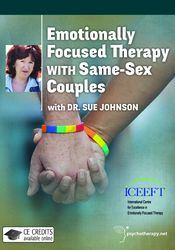 Since its inception in the early 1980s, Emotionally Focused Therapy (EFT) has given therapists a fresh approach for couples counseling. Developed by Dr. Sue Johnson (professor emerita at the University of Ottawa and founder of the International Centre for Excellence in Emotionally Focused Therapy [ICEEFT]) and Dr. Les Greenberg (professor of psychology at York University, Toronto), EFT focuses on the attachment bond between the couple and looks to understand how surface emotions expressed in conflict (what Johnson describes as dreadful dances of negative interactions) are often disguised cries for deeper understanding and a desire for greater intimacy. As the name suggests, this form of therapy focuses on emotions, not cognitions. By untangling the surface emotions and their underlying meaning, the counselor can help the couple identify each step they take in conflicts, deescalate conflicts, identify unmet attachment needs, and restructure interactions so that they learn to bond and meet each other’s deepest needs. The result is a safe and secure attachment bond.
Since its inception in the early 1980s, Emotionally Focused Therapy (EFT) has given therapists a fresh approach for couples counseling. Developed by Dr. Sue Johnson (professor emerita at the University of Ottawa and founder of the International Centre for Excellence in Emotionally Focused Therapy [ICEEFT]) and Dr. Les Greenberg (professor of psychology at York University, Toronto), EFT focuses on the attachment bond between the couple and looks to understand how surface emotions expressed in conflict (what Johnson describes as dreadful dances of negative interactions) are often disguised cries for deeper understanding and a desire for greater intimacy. As the name suggests, this form of therapy focuses on emotions, not cognitions. By untangling the surface emotions and their underlying meaning, the counselor can help the couple identify each step they take in conflicts, deescalate conflicts, identify unmet attachment needs, and restructure interactions so that they learn to bond and meet each other’s deepest needs. The result is a safe and secure attachment bond.
For the most part, EFT has been used to help heterosexual couples improve their relationships. But as the landscape of societal and cultural norms change, counselors can expect to see more gay, lesbian and transgendered couples seeking guidance for relationship struggles. To help counselors cope with the growing tide of same-sex couples seeking services, ICEEFT and Psychotherapy.net present Emotionally Focused Therapy with Same-Sex Couples. This useful video shows Dr. Johnson in action with two same-sex couples (one male couple and one female couple) who are in different stages of reestablishing their damaged attachment bonds. The demonstrations are bookended by conversations between Johnson and each couple’s regular counselor. The video concludes with a very useful conversation in which Johnson and three other counselors discuss the particular nuances of working with same-sex couples.
This video is instructive on two counts. First, for the EFT novice, it shows the master in action. Johnson ably demonstrates two of the three primary stages of EFT—deescalating conflict and restructuring the dance of conflict so that each partner can begin to meet the other’s attachment needs. The stages are the same whether the couple is heterosexual or same-sex, and it is illuminating to watch Johnson review the stages and then help clients reach the stages. In addition, this video also offers insight into the particular issues of same-sex counseling. Counselors who are new to working with same-sex couples—especially heterosexual counselors—should be aware that gay and lesbian couples bring not only the usual conflicts and foibles of relationships into therapy, but also a history of societal indifference and sometimes familial disapproval. As Johnson and her colleagues note, gay and lesbian partners often are even more disconnected from their attachment needs than their heterosexual counterparts. A lifetime of shaming, disapproval from family and friends, and repressing natural desires can adversely affect a person’s ability to fully trust another. Often gay and lesbian youth lack a secure attachment figure—someone to understand and offer warm support—and the lack of this bond makes future relationships tenuous. Johnson encourages the viewer to speak openly about issues of sexuality with same-sex couples, to avoid assumptions about their experiences and to make contact with the trauma each partner may have had when coming out. Attachment can be hard for straight couples, Johnson says, and building secure attachment for couples who grew up hearing that homosexuality was wrong can be even more difficult. That difficulty should be made explicit. As one of the video’s featured counselors quips, counselors working with same-sex couples need to talk about the “pink elephant” in the room.
Even profoundly, the video addresses a common stereotype about same-sex relationships, namely that monogamy is rare in homosexual relationships, which the counselors report is not necessarily true. The need for connection is universal, and now gay and lesbian couples are entering into more traditional forms of relationship (e.g., marriage) than ever before. The video features one couple who have an open relationship, but as the featured counselors say, that arrangement is not necessarily contraindicative of EFT (active affairs outside the “rules” of the relationship are, however). Counselors working with gay and lesbian couples must look beyond the particulars of the relationship (e.g., monogamous, open) to examine the bond between partners. What matters is strengthening the bond. Ultimately, partners want their emotions to be understood, and EFT helps couples reach that goal. This video is highly recommended.
Reviewed by: Eugene Naughton, NCC, professional counselor, Greensboro, North Carolina.
Reel Concepts for Susan Johnson, Inc. (Producer). (2014). Emotionally focused therapy with same-sex couples with Dr. Sue Johnson [DVD]. (Available in DVD and video streaming from http://www.psychotherapy.net/video/emotionally-focused-therapy-gay-lesbian-couples)
Available in DVD and streaming format as part of video subscription at Psychotherapy.net/subscriptions.
The Professional Counselor
http://tpcjournal.nbcc.org
Jan 27, 2015 | Video Reviews
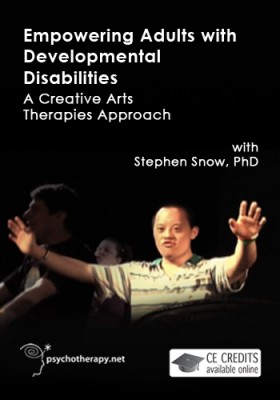
Empowering Adults with Developmental Disabilities: A Creative Arts Therapies Approachwith Steven Snow, PhD is a 42-minute video that focuses on the experiences of a group of people with developmental disabilities at The Centre for the Arts in Human Development at Concordia University. The video is broken up into two sections: “In Their Own Voices” and “Epilogue.”
The first part of the video, “In Their Own Voices,” focuses on a 3-year study Dr. Snow and his colleagues conducted at The Centre for the Arts in Human Development at Concordia University. The study focused on using a form of ethnodramatherapy called “Playback Theater” with adults with developmental disabilities. Playback theater occurs when one of the participants tells a story about something that has happened in his or her life and other participants act out that anecdote. For example, a participant named Angela relates the story of when she went to the bathroom in school and two girls made fun of her. When she went to tell her teacher, her teacher said that she was making up a lie. As part of playback theater, other project participants act out Angela’s story in the form of a skit. In addition, participants perform another skit about living in a world where name calling is against the law. Some participants note that they are uncomfortable repeating negative names in the play because they are names that others have called them.
The video narrator emphasizes that it is important to follow up with participants who have told their stories to see whether the skits have accurately reflected their narratives. This follow-up can occur in the form of processing feelings in a group setting or using art therapy. At one point, Dr. Snow brings in art therapists to help participants convey their thoughts and feelings through artwork. One participant is described as someone who does not speak often, but is shown expressing herself on stage through the use of finger painting. Participants also are encouraged to express themselves through dance with the help of dance movement coaches and dance therapy. The video discusses the definition of the word “stigma” and how people with disabilities face stigma in their daily lives. Some participants describe frustrations with being unable to do things other people are able to do such as catch the city bus on their own. The first section of the video concludes with the participants putting on a play for the community in which they incorporate everything they have learned from participating in the project.
The second section of the video, titled “Epilogue,” gives more in-depth information about the concept of ethnodramatherapy and how Dr. Snow and his colleagues have used this therapy with program participants. Dr. Snow discusses how to incorporate expressive and performance art into work with adults with developmental disabilities to help them to cope with issues of daily living. He reports that the research team has conducted participant interviews as a way of collecting qualitative data to measure the therapeutic impact of ethnodramatherapy.
This video would be appropriate for graduate students in counseling, especially those studying rehabilitation counseling, to understand the unique experiences of adults with developmental disabilities and how counseling can be more than just talk therapy. This video also would be an excellent resource for current practitioners who are looking for more creative ways to work with adults with specials needs. Introductory counseling students may have trouble following the Epilogue, as it focuses heavily on the methodology used by the research team during the project. However, counselor educators will find this section interesting when considering more creative ways to measure therapeutic outcomes and impact from a qualitative perspective. Overall, this video helps all audiences to remember what one participant boldly stated: “Labels don’t belong to anyone. Labels belong on jars.”
Reviewed by: Jessica L. Martin, doctoral student in counselor education, University of Central Florida, Orlando, Florida.
Psychotherapy.net (Producer), & Herbison, P. (Director). (2014). Empowering Adults with Developmental Disabilities: A Creative Arts Therapies Approach with Stephen Snow, PhD [DVD]. (Available in DVD and video streaming from http://www.psychotherapy.net/video/developmental-disabilities-therapy-video)
Available in DVD and streaming format as part of video subscription at Psychotherapy.net/subscriptions.
The Professional Counselor
http://tpcjournal.nbcc.org
Dec 15, 2014 | Video Reviews
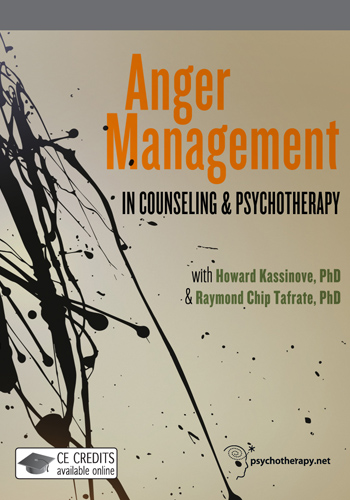 Anger is an emotion that everyone experiences at one time or another. Unfortunately, some people acquire unhealthy ways to manage their anger. In their DVD Anger Management in Counseling & Psychotherapy, Howard Kassinove and Raymond Chip Tafrate present the viewer with a model of psychotherapy techniques geared toward helping counselor educators and clinicians navigate distinctive anger interventions. The DVD’s main purpose is to be used as an adjunct to their text, Anger Management: The Complete Treatment Guidebook for Practitioners; however, the videos can be valuable if viewed individually.
Anger is an emotion that everyone experiences at one time or another. Unfortunately, some people acquire unhealthy ways to manage their anger. In their DVD Anger Management in Counseling & Psychotherapy, Howard Kassinove and Raymond Chip Tafrate present the viewer with a model of psychotherapy techniques geared toward helping counselor educators and clinicians navigate distinctive anger interventions. The DVD’s main purpose is to be used as an adjunct to their text, Anger Management: The Complete Treatment Guidebook for Practitioners; however, the videos can be valuable if viewed individually.
The video series presents a solid conceptualization of anger and anger management in counseling. The presenters’ main approach is to characterize anger as disconnected from hostility and aggression. In order to support this idea, they have developed an Anger Episode Model to help clients highlight their most troubled areas in relation to anger and to recognize that there is a specific anger problem. In an overview, the authors display a sequence of videos demonstrating techniques to help clients cope with their anger through assessment and awareness. In addition to the introduction and the final comments, there are seven video chapters titled Increasing Awareness, The Anger Episode Model, Progressive Muscle Relaxation, Social Problem Solving, Rational Emotive Behavior Therapy, The Barb Technique and The Outcome of Forgiving.
Tafrate and Kassinove explain the Anger Episode Model in relation to clients in anger management counseling, and also provide examples through actual interviews with real clients. In these interviews, the presenters utilize the techniques and skills discussed within the video chapters. These examples are especially helpful resources for clinicians, as Tafrate and Kassinove not only explain the skills, but also demonstrate them in a realistic environment. Paradoxically, this asset to the video series also can be a limitation, because the interviews may not portray the counseling techniques with clear fluidity, as the presenters must go with the flow of a real counseling session. Furthermore, because every client’s situation is unique, at times there may not be a clear process for how the clinicians should apply the model in a particular situation. In addition to the interview examples, the DVD also includes a helpful Instructor’s Manual. In this manual, Kassinove and Tafrate provide discussion questions, role-play activities, reaction paper ideas and other resources for instructors to use when teaching a class how to implement anger management in counseling.
Counselor educators and clinicians will benefit from this video series given that the videos present real clients in a real clinical setting. Viewers will be able to appreciate the authentic process of the sessions and gain a better feel for what happens during interventions. Overall, this video series is a great resource for counselors and counselor educators. The presenters explain techniques clearly and concisely, and the model and techniques demonstrated in this series effectively convey anger management as a therapeutic task and provide a holistic approach to helping clients manage their anger. This video set is an effective addition to the Anger Management textbook and serves as a more hands-on teaching tool for counselor educators to include in their classrooms.
Reviewed by Coralis Solomon and Shaywanna Harris, doctoral students in counselor education, University of Central Florida, Orlando, Florida.
Impact Publishers (Producer). (2014). Anger management in counseling & psychotherapy with Howard Kassinove, PhD & Raymond Chip Tafrate, PhD [DVD]. (Available in DVD and video streaming from http://www.psychotherapy.net/video/anger-management-psychotherapy)
Available in DVD and streaming format as part of video subscription at Psychotherapy.net/subscriptions.
The Professional Counselor
http://tpcjournal.nbcc.org
Dec 15, 2014 | Video Reviews
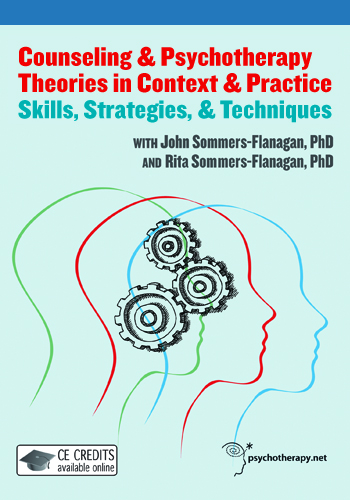 Counseling & Psychotherapy Theories in Context and Practice: Skills, Strategies, and Techniques is an educational video of just under 4 and a half hours prepared by professors John Sommers-Flanagan, PhD and Rita Sommers-Flanagan, PhD based on their textbook Counseling and Psychotherapy Theories in Context and Practice, and demonstrates certain techniques and strategies for 11 different psychotherapy approaches throughout theory-based counseling sessions. The theories covered in the video are psychoanalytic, Adlerian, existential, person-centered, Gestalt, behavior, cognitive-behavioral, reality, feminist, solution-focused and family systems. Each counseling session takes approximately 20 minutes and is conducted with real people with real problems. The video has 12 chapters, including an introduction and 11 theory-based counseling sessions. Each segment demonstrates a specific theory and is divided into two parts; during the break within each session, Drs. John and Rita Sommers-Flanagan talk about what happened in the first part and give information about the second part. In addition, before and after each session, the professors preview and review the concepts, techniques and strategies covered in the session.
Counseling & Psychotherapy Theories in Context and Practice: Skills, Strategies, and Techniques is an educational video of just under 4 and a half hours prepared by professors John Sommers-Flanagan, PhD and Rita Sommers-Flanagan, PhD based on their textbook Counseling and Psychotherapy Theories in Context and Practice, and demonstrates certain techniques and strategies for 11 different psychotherapy approaches throughout theory-based counseling sessions. The theories covered in the video are psychoanalytic, Adlerian, existential, person-centered, Gestalt, behavior, cognitive-behavioral, reality, feminist, solution-focused and family systems. Each counseling session takes approximately 20 minutes and is conducted with real people with real problems. The video has 12 chapters, including an introduction and 11 theory-based counseling sessions. Each segment demonstrates a specific theory and is divided into two parts; during the break within each session, Drs. John and Rita Sommers-Flanagan talk about what happened in the first part and give information about the second part. In addition, before and after each session, the professors preview and review the concepts, techniques and strategies covered in the session.
The concepts of many theories may be confusing for some students and novice counselors. However, real people present with real problems in the video, enabling the audience to make better sense of many theories and the application of their concepts in session. For example, the family constellation concept of Adlerian therapy might seem abstract to some students and professionals. Therefore, in the related section, Dr. John Sommers-Flanagan demonstrates how to implement and use the family constellation concept in a counseling session. Another example is the video’s clear presentation of Gestalt therapy’s empty chair technique. One other advantage of the video is the opportunity to watch sessions with members of varied populations, such as individuals, families and children, as well as clients from diverse backgrounds, such as Muslim clients.
One possible limitation of the video might be that, in order to follow the demonstrated techniques and strategies, a person might need basic information about the theories. Otherwise, it could be difficult to follow and fully understand presented theories. However, the segments do cover some basic concepts of the theories, and it is understood that it is not possible to cover every aspect of 11 different theories in a video.
An instructional manual by Shirin Shoai, MA is provided with the video, which reviews each theory and provides guidelines for instructors and any audience. The manual also provides possible topics and guidelines for role plays, group activities and reflection papers, which instructors can use as classroom activities. In addition, the manual contains recommended readings and Web sites as additional resources. Another important aspect of this video is that earning continuing education (CE) credits is possible. The information about CE credits is presented in both the video and the manual.
This video can be used for educational purposes by counselor educators, instructors, students, supervisors or counseling professionals. An instructor or a counselor educator can easily use the video in theory classes as a classroom or homework activity. The manual is undoubtedly useful and directive for instructors. The video also is a good resource for students for reviewing and seeing the application of presented theories. Students can easily watch the video by themselves without direction. Additionally, supervisors can use the video as a resource for their supervisees. Finally, as mentioned before, CE credits are available for this DVD. Thus, the video is a good opportunity for professionals to review techniques and strategies as well as earn CE credits.
In summary, this video is well-prepared and organized for students, educators, supervisors and professionals. Thanks to this video, it is possible to learn about the application of 11 theories and various techniques and strategies. The video can be easily used in educational settings and for professional development.
Reviewed by: Abdi Gungor, doctoral student in counselor education, University of Central Florida, Orlando, Florida.
Irish Luck Productions (Producer), & Sommers-Flanagan, J., & Sommers-Flanagan, R. (Directors). (2014). Counseling & Psychotherapy Theories in Context and Practice: Skills, Strategies, and Techniques with John Sommers-Flanagan, PhD and Rita Somers-Flanagan, PhD [DVD]. (Available in DVD and video streaming fromhttp://www.psychotherapy.net/video/counseling-psychotherapy-theories)
Available in DVD and streaming format as part of video subscription at Psychotherapy.net/subscriptions.
The Professional Counselor
http://tpcjournal.nbcc.org
Dec 15, 2014 | Video Reviews
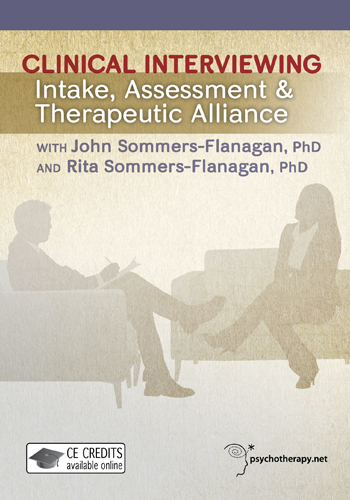 Overall, the Clinical Interviewing: Intake, Assessment, and Therapeutic Alliance video is a great product and I would recommend it to my students and colleagues. The video is associated with a textbook titled Clinical Interviewing (Wiley, 2014) and written by the video presenters, Professors John and Rita Sommers-Flanagan. The professors begin with basic interview skills and end with complex interviewing skills. The basic interview skills consist of the following: nondirective listening behaviors (i.e. Ivey’s attending behaviors) and responses, directive listening and action responses, and questions. Nondirective listening behaviors include the following: eye contact, body posture, voice tone and verbal tracking; and nondirective listening responses consist of the following: silence, clarification, paraphrasing, reflection of feeling and summarization. In contrast, directive listening and action responses include feeling validation, interpretive reflection of feeling, interpretation, reframe and confrontation. And the types of questions included are open, closed, indirect, swing, projective and therapeutic. The complex interviewing skills explained are intake assessment, mental status examination and suicide assessment. The professors provide lengthy demonstrations of how to complete a mental status examination and suicide assessment, which give the audience a good idea of how these assessments should be conducted.
Overall, the Clinical Interviewing: Intake, Assessment, and Therapeutic Alliance video is a great product and I would recommend it to my students and colleagues. The video is associated with a textbook titled Clinical Interviewing (Wiley, 2014) and written by the video presenters, Professors John and Rita Sommers-Flanagan. The professors begin with basic interview skills and end with complex interviewing skills. The basic interview skills consist of the following: nondirective listening behaviors (i.e. Ivey’s attending behaviors) and responses, directive listening and action responses, and questions. Nondirective listening behaviors include the following: eye contact, body posture, voice tone and verbal tracking; and nondirective listening responses consist of the following: silence, clarification, paraphrasing, reflection of feeling and summarization. In contrast, directive listening and action responses include feeling validation, interpretive reflection of feeling, interpretation, reframe and confrontation. And the types of questions included are open, closed, indirect, swing, projective and therapeutic. The complex interviewing skills explained are intake assessment, mental status examination and suicide assessment. The professors provide lengthy demonstrations of how to complete a mental status examination and suicide assessment, which give the audience a good idea of how these assessments should be conducted.
This video has a number of strengths. The material is presented developmentally, from basic interviewing skills to complex interviewing skills. The video features an option of viewing the entire presentation or selecting specific chapters that correspond with the clinical skills covered in the video. The chapters are well organized and all use the following format: (a) an introduction to the clinical skills to be covered in that chapter, (b) a brief lecture on those skills and how they are incorporated into sessions, (c) a clip of an actual session during which the counselor demonstrates the use of the skills, and (d) a debriefing of the session by the presenters, at which time they discuss the things that were done well and things that could have been done differently. In addition, at the beginning of each chapter the professors summarize the skills covered in previous chapter(s). The video also comes with a manual that provides an overview of the video and additional activities that can be completed along with it.
During the introduction to the video, Professors John and Rita Sommers-Flanagan stress the importance of being culturally aware of and sensitive to each individual client’s needs, and using one’s best clinical judgment when utilizing clinical interviewing skills. The importance of being culturally sensitive is stressed several times throughout the video. The professors also incorporate PowerPoint slides into the video, which are very helpful because the slides highlight key points that are discussed in each chapter prior to the demonstration of the clinical skills. In addition, during the demonstration sessions, whenever the counselor uses specific skills, the skills are identified at the bottom of the screen.
As previously stated, overall this video is a great resource; however, there are a couple of limitations worth noting. The material is presented from a limited client perspective in that the professors only focus on individual adult clients. During the brief lectures and discussions about different clinical skills, the professors do not mention how the skills might look different when used with couples, families, adolescents, older adults, etc. The presenters mainly focus on how a client’s culture influences the counseling process; they do not highlight the ways that different modalities and client characteristics might affect how clinical skills are implemented during a session. Furthermore, the feature of displaying which skills the counselors are using is both a strength and limitation; the limitation is the lack of an option to manipulate this function (turn it on/off). Providing the ability for an instructor to manipulate this function would offer him or her more options for classroom activities.
The video is structured for both instructional and independent use, so it can be used by counseling professionals. Counselor educators and other mental health educators can incorporate the video into their courses by showing the video in class or making it available for students to access outside class. Furthermore, professional counselors can use the video to independently to strengthen their clinical interviewing skills.
Reviewed by: Olivia Uwamahoro, NCC, doctoral candidate in counselor education, University of Central Florida, Orlando, Florida.
Irish Luck Productions (Producer), & Sommers-Flanagan, J., & Sommers-Flanagan, R. (Directors). (2014). Clinical interviewing: Intake, assessment, and therapeutic alliance with John Sommers-Flanagan, PhD and Rita Sommers-Flanagan, PhD [DVD]. (Available in DVD and video streaming from http://www.psychotherapy.net/video/clinical-interview-intake-assessment-training)
Available in DVD and streaming format as part of video subscription at Psychotherapy.net/subscriptions.
The Professional Counselor
http://tpcjournal.nbcc.org



 Anger is an emotion that everyone experiences at one time or another. Unfortunately, some people acquire unhealthy ways to manage their anger. In their DVD Anger Management in Counseling & Psychotherapy, Howard Kassinove and Raymond Chip Tafrate present the viewer with a model of psychotherapy techniques geared toward helping counselor educators and clinicians navigate distinctive anger interventions. The DVD’s main purpose is to be used as an adjunct to their text, Anger Management: The Complete Treatment Guidebook for Practitioners; however, the videos can be valuable if viewed individually.
Anger is an emotion that everyone experiences at one time or another. Unfortunately, some people acquire unhealthy ways to manage their anger. In their DVD Anger Management in Counseling & Psychotherapy, Howard Kassinove and Raymond Chip Tafrate present the viewer with a model of psychotherapy techniques geared toward helping counselor educators and clinicians navigate distinctive anger interventions. The DVD’s main purpose is to be used as an adjunct to their text, Anger Management: The Complete Treatment Guidebook for Practitioners; however, the videos can be valuable if viewed individually. Counseling & Psychotherapy Theories in Context and Practice: Skills, Strategies, and Techniques is an educational video of just under 4 and a half hours prepared by professors John Sommers-Flanagan, PhD and Rita Sommers-Flanagan, PhD based on their textbook Counseling and Psychotherapy Theories in Context and Practice, and demonstrates certain techniques and strategies for 11 different psychotherapy approaches throughout theory-based counseling sessions. The theories covered in the video are psychoanalytic, Adlerian, existential, person-centered, Gestalt, behavior, cognitive-behavioral, reality, feminist, solution-focused and family systems. Each counseling session takes approximately 20 minutes and is conducted with real people with real problems. The video has 12 chapters, including an introduction and 11 theory-based counseling sessions. Each segment demonstrates a specific theory and is divided into two parts; during the break within each session, Drs. John and Rita Sommers-Flanagan talk about what happened in the first part and give information about the second part. In addition, before and after each session, the professors preview and review the concepts, techniques and strategies covered in the session.
Counseling & Psychotherapy Theories in Context and Practice: Skills, Strategies, and Techniques is an educational video of just under 4 and a half hours prepared by professors John Sommers-Flanagan, PhD and Rita Sommers-Flanagan, PhD based on their textbook Counseling and Psychotherapy Theories in Context and Practice, and demonstrates certain techniques and strategies for 11 different psychotherapy approaches throughout theory-based counseling sessions. The theories covered in the video are psychoanalytic, Adlerian, existential, person-centered, Gestalt, behavior, cognitive-behavioral, reality, feminist, solution-focused and family systems. Each counseling session takes approximately 20 minutes and is conducted with real people with real problems. The video has 12 chapters, including an introduction and 11 theory-based counseling sessions. Each segment demonstrates a specific theory and is divided into two parts; during the break within each session, Drs. John and Rita Sommers-Flanagan talk about what happened in the first part and give information about the second part. In addition, before and after each session, the professors preview and review the concepts, techniques and strategies covered in the session. Overall, the Clinical Interviewing: Intake, Assessment, and Therapeutic Alliance video is a great product and I would recommend it to my students and colleagues. The video is associated with a textbook titled Clinical Interviewing (Wiley, 2014) and written by the video presenters, Professors John and Rita Sommers-Flanagan. The professors begin with basic interview skills and end with complex interviewing skills. The basic interview skills consist of the following: nondirective listening behaviors (i.e. Ivey’s attending behaviors) and responses, directive listening and action responses, and questions. Nondirective listening behaviors include the following: eye contact, body posture, voice tone and verbal tracking; and nondirective listening responses consist of the following: silence, clarification, paraphrasing, reflection of feeling and summarization. In contrast, directive listening and action responses include feeling validation, interpretive reflection of feeling, interpretation, reframe and confrontation. And the types of questions included are open, closed, indirect, swing, projective and therapeutic. The complex interviewing skills explained are intake assessment, mental status examination and suicide assessment. The professors provide lengthy demonstrations of how to complete a mental status examination and suicide assessment, which give the audience a good idea of how these assessments should be conducted.
Overall, the Clinical Interviewing: Intake, Assessment, and Therapeutic Alliance video is a great product and I would recommend it to my students and colleagues. The video is associated with a textbook titled Clinical Interviewing (Wiley, 2014) and written by the video presenters, Professors John and Rita Sommers-Flanagan. The professors begin with basic interview skills and end with complex interviewing skills. The basic interview skills consist of the following: nondirective listening behaviors (i.e. Ivey’s attending behaviors) and responses, directive listening and action responses, and questions. Nondirective listening behaviors include the following: eye contact, body posture, voice tone and verbal tracking; and nondirective listening responses consist of the following: silence, clarification, paraphrasing, reflection of feeling and summarization. In contrast, directive listening and action responses include feeling validation, interpretive reflection of feeling, interpretation, reframe and confrontation. And the types of questions included are open, closed, indirect, swing, projective and therapeutic. The complex interviewing skills explained are intake assessment, mental status examination and suicide assessment. The professors provide lengthy demonstrations of how to complete a mental status examination and suicide assessment, which give the audience a good idea of how these assessments should be conducted.